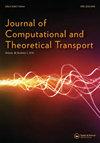辐射传递问题的渐近PN逼近
IF 1.1
4区 工程技术
Q3 MATHEMATICS, APPLIED
Journal of Computational and Theoretical Transport
Pub Date : 2020-11-03
DOI:10.1080/23324309.2020.1845738
引用次数: 3
摘要
摘要我们研究了含时渐近PN近似在光子辐射传输中的有效性。含时渐近PN是一种使用标准PN方程的近似,其闭包基于齐次问题的精确Boltzmann方程在空间和时间上的渐近解。辐射传输的渐近PN近似需要仔细处理封闭方程。具体来说,由于内部或外部辐射源的原因,每次碰撞发射的粒子的平均数量()可能大于1,并且在这些情况下必须扩展闭合系数。我们的近似值是根据一个众所周知的辐射传输基准进行测试的。它产生了极好的结果,具有几乎正确的粒子速度来控制辐射热波前。本文章由计算机程序翻译,如有差异,请以英文原文为准。
Asymptotic PN Approximation in Radiative Transfer Problems
Abstract We study the validity of the time-dependent asymptotic PN approximation in radiative transfer of photons. The time-dependent asymptotic PN is an approximation which uses the standard PN equations with a closure that is based on the asymptotic solution of the exact Boltzmann equation for a homogeneous problem, in space and time. The asymptotic PN approximation for radiative transfer requires careful treatment regarding the closure equation. Specifically, the mean number of particles that are emitted per collision ( ) can be larger than one due to inner or outer radiation sources and the coefficients of the closure must be extended for these cases. Our approximation is tested against a well-known radiative transfer benchmark. It yields excellent results, with almost correct particle velocity that controls the radiative heat-wave fronts.
求助全文
通过发布文献求助,成功后即可免费获取论文全文。
去求助
来源期刊

Journal of Computational and Theoretical Transport
Mathematics-Mathematical Physics
CiteScore
1.30
自引率
0.00%
发文量
15
期刊介绍:
Emphasizing computational methods and theoretical studies, this unique journal invites articles on neutral-particle transport, kinetic theory, radiative transfer, charged-particle transport, and macroscopic transport phenomena. In addition, the journal encourages articles on uncertainty quantification related to these fields. Offering a range of information and research methodologies unavailable elsewhere, Journal of Computational and Theoretical Transport brings together closely related mathematical concepts and techniques to encourage a productive, interdisciplinary exchange of ideas.
 求助内容:
求助内容: 应助结果提醒方式:
应助结果提醒方式:


